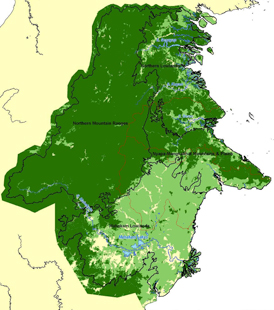30% of East Kalimantan’s forests destroyed, inclduing 76% of Mahakam Lowlands.
30 percent of forests and peatlands in Indonesia’s East Kalimantan has been destroyed, while a substantial extent of the remainder has been damaged, finds a new assessment that identifies key areas for preservation.
The study, conducted by Daemeter Consulting on behalf of The Nature Conservancy (TNC), finds that more than three-quarters of the forest in the Mahakam Lowlands has been lost since 1975. Up to 2 million hectares of natural ecosystems across the province are slated for conversion.
The assessment concludes that two-thirds of the province’s 1.5 million hectares of endangered ecosystems lie in the Mahakam Lowlands. Mountainous areas had more intact forest and face substantially lower risk.
The study is significant because it is the first high conservation value (HCV) assessment to be completed using methods developed specifically for Indonesia.
“This ground-breaking study provides decision-makers with highly detailed HCV maps showing where the critically important forest areas are in East Kalimantan, using a priority system which was developed and approved by Indonesian stakeholders,” said Christopher Stewart, the past Manager of the HCV Resource Network, which is hosting the report. “Some of the lowland ecosystems in East Kalimantan have lost over 90% of their area in the last four decades – the fate of many species lies in the hands of responsible companies, communities and individuals, and I hope that they – and the certification systems which verify the claims of responsible palm and forestry operations – will use this tool to help conserve the last remnants of these nationally and internationally important forests.”
The authors say the report could help support commodity certification initiatives and land use planning efforts in East Kalimantan that incorporate HCV principles and practices.

